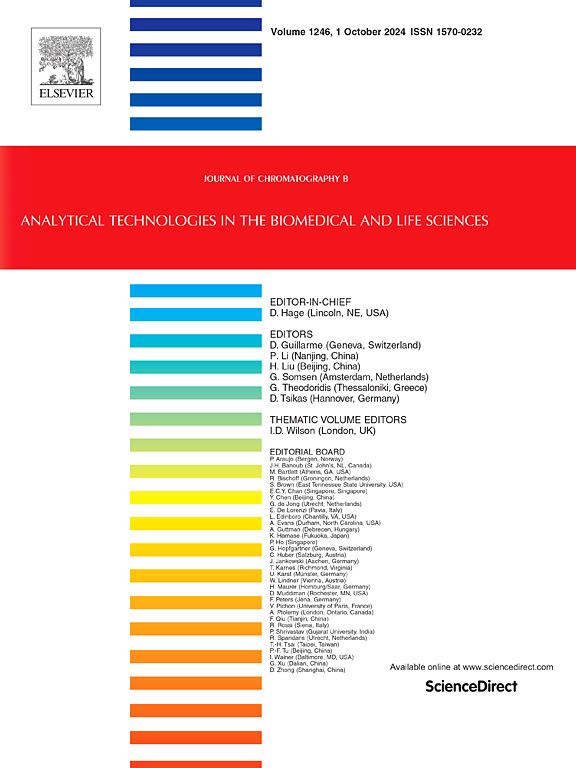Optimization of natural deep eutectic solvent composition for ultrasound-assisted extraction of phenolic compound from propolis samples
IF 2.8
3区 医学
Q2 BIOCHEMICAL RESEARCH METHODS
引用次数: 0
Abstract
Propolis is a resinous substance collected by bees rich in bioactive phenolic compounds, which confer medicinal properties, making it highly commercialized. Thus, this study aimed to develop a green method of ultrasound-assisted extraction using a natural deep eutectic solvent (NADES) to determine bioactive phenolic compounds in propolis by HPLC-DAD. A mixture design was conducted to optimize the proportion of components in the NADES synthesis, evaluating the components lactic acid, glucose, and water. The best molar ratio was determined to be 2:1:30. To obtain the optimal experimental conditions for the phenolic compound extraction procedure using NADES, the factors NADES volume and sonication time were evaluated using a Doehlert matrix as the response surface methodology, and the optimal conditions were 3.5 mL and 21 min, respectively. Analytical curves were constructed based on the peak areas of standard solutions of vanillic acid, rutin, gallic acid, trans-cinnamic acid, catechin, syringic acid, d-hydroxybenzoic acid, p-coumaric acid, caffeic acid, chlorogenic acid, ferulic acid, and sinapic acid. The detection limits ranged from 0.09 to 0.4 mg L−1. The method presented good precision and accuracy and was applied to determining 12 phenolic compounds in three propolis samples. Furthermore, the proposed method was evaluated as a green alternative for determining phenolic compounds in propolis samples using AGREE and AGREEprep metrics. The final result of these metrics confirms that this method is aligned with Green Analytical Chemistry (GAC) principles.
超声辅助提取蜂胶中酚类化合物的天然深共熔溶剂组成优化
蜂胶是一种由蜜蜂收集的树脂状物质,富含生物活性酚类化合物,具有药用特性,使其高度商业化。因此,本研究旨在建立一种绿色的超声辅助提取方法,利用天然深共熔溶剂(NADES), HPLC-DAD法测定蜂胶中的生物活性酚类化合物。通过对乳酸、葡萄糖、水的配比进行评价,优化NADES合成过程中各组分的配比。确定最佳摩尔比为2:1:30。以Doehlert矩阵为响应面法,考察NADES体积和超声时间的影响因素,确定NADES体积为3.5 mL,超声时间为21 min,以获得NADES提取酚类化合物的最佳实验条件。根据香草酸、芦丁、没食子酸、反式肉桂酸、儿茶素、丁香酸、d-羟基苯甲酸、对香豆酸、咖啡酸、绿原酸、阿魏酸和辛酸标准溶液的峰面积构建分析曲线。检出限为0.09 ~ 0.4 mg L−1。该方法具有良好的精密度和准确度,可用于测定3种蜂胶样品中的12种酚类化合物。此外,所提出的方法被评估为使用AGREE和AGREEprep指标测定蜂胶样品中酚类化合物的绿色替代方法。这些指标的最终结果证实,该方法符合绿色分析化学(GAC)原则。
本文章由计算机程序翻译,如有差异,请以英文原文为准。
求助全文
约1分钟内获得全文
求助全文
来源期刊

Journal of Chromatography B
医学-分析化学
CiteScore
5.60
自引率
3.30%
发文量
306
审稿时长
44 days
期刊介绍:
The Journal of Chromatography B publishes papers on developments in separation science relevant to biology and biomedical research including both fundamental advances and applications. Analytical techniques which may be considered include the various facets of chromatography, electrophoresis and related methods, affinity and immunoaffinity-based methodologies, hyphenated and other multi-dimensional techniques, and microanalytical approaches. The journal also considers articles reporting developments in sample preparation, detection techniques including mass spectrometry, and data handling and analysis.
Developments related to preparative separations for the isolation and purification of components of biological systems may be published, including chromatographic and electrophoretic methods, affinity separations, field flow fractionation and other preparative approaches.
Applications to the analysis of biological systems and samples will be considered when the analytical science contains a significant element of novelty, e.g. a new approach to the separation of a compound, novel combination of analytical techniques, or significantly improved analytical performance.
 求助内容:
求助内容: 应助结果提醒方式:
应助结果提醒方式:


